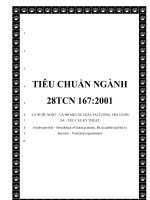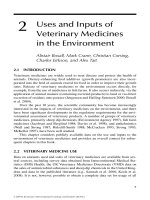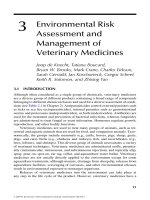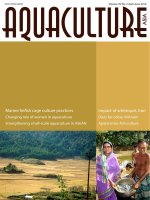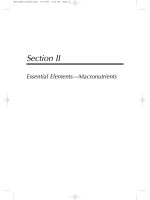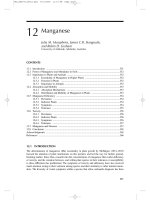Small-scale freshwater fish farming - Chapter 5,6 ppt
Bạn đang xem bản rút gọn của tài liệu. Xem và tải ngay bản đầy đủ của tài liệu tại đây (117.92 KB, 8 trang )
Small-scale freshwater fish farming
40
Part II: Planning a fish farm
Figure 24: Setting up a fish farm
Introduction
41
5 Introduction
Land, water and climatic conditions are probably the most important
natural factors that need to be assessed. When developing a site for
fish farming you should consider the effect it may have on the envi-
ronment. Important natural areas (e.g. fish nursery grounds like man-
grove forests) should not be used for fish farming.
One of the most essential requirements is water availability, in terms
of quality and quantity. The type of aquaculture farm and species of
animals or plants that you will be able to culture will depend largely
on the properties of the site.
The risks involved in fish farming should also be stressed. Fish need
protein in order to grow and reproduce. This means they can become
competitors for products, which could otherwise be used directly for
human consumption. Furthermore, the cost of production is fairly high
and therefore fish grown in ponds are not always able to compete fi-
nancially with fish caught in the wild.
Setting up a fish farm involves high initial investment and high pro-
duction costs as well as economic risks. Therefore, there are some
very important factors a prospective fish farmer should consider be-
fore embarking on a fish farming venture (see figure 24). For exam-
ple:
1 Gathering information:
Future fish farmers can often get assistance with starting up a fish
farming enterprise in the form of technical advice from extension ser-
vices. In some cases even financial support is provided.
2 Finance:
A cost estimate should include the cost of land as well as capital ex-
penditures for fish stock, pond construction, labour, production and
harvesting.
Small-scale freshwater fish farming
42
3 Site:
The soil must be able to retain water. Good water quality and suffi-
cient quantity should be available at a reasonable cost. The site should
be close to home and potential losses from stealing should be esti-
mated. The ownership of the land, as well as the state or federal per-
mits required, should be known and obtained. The site and roads
should be passable and not subject to flooding.
4 Fish stock:
You need to decide whether to breed your own fish stock or purchase
it from others. If you plan to buy from others you must have a reliable
source of good quality fish stock. If you choose to breed on-site, then
you must have adequate space for maintenance of brood stock and
production of young fish.
5 Production:
Will the feed available for the selected fish species match this species
preferences?
6 Harvesting:
Enough people should be available to harvest the fish. Find out what
is the most economical method for harvesting. You may need storage
facilities for harvested fish.
7 Consumption:
Will the fish be used for your own consumption or for selling?
Selecting the site and type of fish farm
43
6 Selecting the site and type of fish
farm
Site selection
Proper selection of a site is probably the most important factor for
success. However, if the ideal site is not available, you may have to
compromise. There may also be conflicts concerning land and water
use that need to be resolved. You should decide on which species to
raise, based on the available feeds (e.g. agricultural by-products) and
possible fertilisers (e.g. compost or animal manure).
Site selection will depend on the type of fish farm you plan to run. For
pond construction you need to consider the following factors: soil type
and quality and quantity of the water available.
Soil
The quality of soil influences both water quality and productivity in a
pond. The soil must also be suitable for dike construction. To deter-
mine soil suitability the two most important properties to examine are
soil texture (particle size composition), and porosity or permeability
(ability to let water pass through). The pond bottom must be able to
hold water (have a low porosity, like clay) and the soil should also
contribute to the fertility of the water by providing nutrients. The best
soil for pond construction should contain a lot of clay. The three
methods one should follow to predict whether the soil will be suitable
for pond construction are:
1 The ‘squeeze method’
2 The ground water test
3 The water permeability test
1 Squeeze method (figure 25):
a Wet a handful of soil with just enough water to make it moist
b Squeeze the soil by closing your hand firmly
c If it holds its shape after opening the palm of your hand, the soil
will be good for pond construction.
Small-scale freshwater fish farming
44
Figure 25: The ‘squeeze method’ (Chakroff, 1976)
2 Ground water test (figure 26)
This test should be performed during the dry period in order to get
reliable results:
a Dig a hole to a depth of one metre
b Cover it with leaves for one night to limit evaporation
c If the hole is filled with ground water the next morning, a pond
could be built but take into account that you will probably need
more time to drain the pond. This is due to the high ground water
levels that will refill the pond.
d If the hole is still empty the next morning, no problems will occur
as a result of high ground water levels and the site will probably be
suitable for pond fish farming. Now you should test the soil perme-
ability to water.
Figure 26: Ground water test (Viveen et al., 1985)
Selecting the site and type of fish farm
45
3 Water permeability test (figure 27):
a Fill the hole with water to the top
b Cover the hole with leaves
c The following day the water level will be lower due to seepage.
The dikes of the hole have probably become saturated with water
and might hold water better now.
d Refill the hole with water to the top
e Cover it once more with leaves. Check the water level the next day.
f If the water level is still high, the soil is impermeable enough and is
suitable for pond construction.
g If the water has disappeared again, the site is not suitable for fish
farming, unless the bottom is first covered with plastic or heavy
clays.
Figure 27: Water permeability test (Viveen et al., 1985)
Small-scale freshwater fish farming
46
The land contour and especially the land slope determine the way the
pond should be built. The slope of the land can be used for the pond's
drainage at harvest.
Totally flat land and a hilly terrain with a slope of more than 4% are
unsuitable for pond construction. All slopes between 2% and 4% can
be used for pond construction. A 2% land slope indicates a 2 cm drop
in elevation for every metre of horizontal distance. If the slope is ade-
quate, you can fill and drain by the simple means of gravity. However,
you should take care to prevent erosion of the pond dikes.
Water
The availability of good water quality is significant for all fish farm-
ing systems but water quantity is of even greater importance for land-
based fish farming systems. A constant water supply is needed, not
only to fill the pond, but also to make up for the losses caused by
seepage and evaporation (figure 28).
Figure 28: Water supply and water loss in a fish pond (Viveen et
al. 1985) a: inlet, b: overflow, c: evaporation, d: seepage
Investigation of the water sources is very important:
1 How much water is available?
2 Is water available in all seasons, or is the availability different dur-
ing the different the seasons?
3 What are the water sources? Are they likely to be polluted?
Selecting the site and type of fish farm
47
Ideally, water should be available all year round. Different water
sources and their disadvantages are listed in table 2.
Water temperature
Water temperature is an important condition in assessing whether the
fish species selected can be raised. A water temperature between 20 °C
and 30 °C is generally good for fish farming.
Water salinity
Variation in water salinity (amount of dissolved salts in the water) is
also an important factor to consider. Some fish species can withstand a
wider salinity range than others: e.g. tilapia and catfish can withstand
a wide range from freshwater to seawater, while carp can only with-
stand freshwater.
These are the most important water quality criteria for site selection.
There are other important water quality characteristics, but these are
more easily controlled by management measures (for example, dis-
solved oxygen, pH, etc., see chapter 4).
Table 2: Water sources and their main disadvantages
Water source Main disadvantage
Rainfall
‘Sky’ ponds rely on rainfall only to supply water
Dependency
The supply depends heavily on amount of
rain and seasonal fluctuations
Run-off
Ponds can be filled when water from the sur-
rounding land area runs into them
High turbidity
Turbidity is the amount of mud in the wa-
ter. In case of run-off the water may be
muddy. Danger of flooding and pesticides
(or other pollutants) in the water
Natural waters
Water can be diverted and brought in from
streams, rivers or lakes
Contamination
Animals, plants and rotting organisms can
cause diseases. Danger of pesticides (or
other pollutants) in the water
Springs
Spring water is water under the ground that has
found a way to get out. Spring water is good for
fish ponds because it is usually clean.
Low oxygen level and low temperature
Wells
Wells are places where ground water is
pumped up
Low oxygen level and low temperature
